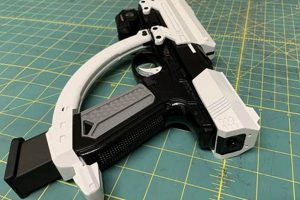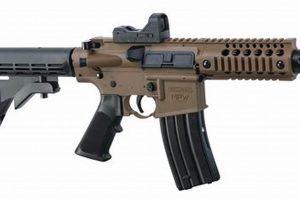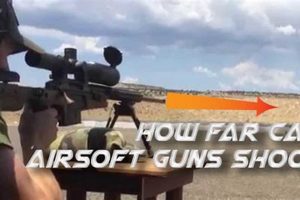In airsoft weaponry, a mechanism exists to impart backspin on projectiles as they are fired. This backspin generates a lift force, known as the Magnus effect, which counteracts the downward pull of gravity. The result is an increase in the effective range and accuracy of the projectile. This critical component is a near-ubiquitous feature in modern airsoft replicas.
Its presence dramatically improves the usability of an airsoft gun. Without it, projectiles would drop significantly over short distances, making accurate shots at even moderate ranges extremely difficult. The invention and refinement of this system represent a significant advancement in airsoft technology, enabling more realistic and engaging gameplay. Early iterations were often rudimentary and less effective than contemporary designs, showcasing the evolution of airsoft technology.
The subsequent sections will detail the specific components, the adjustment mechanisms, common issues encountered, and maintenance procedures associated with this performance-enhancing mechanism. Understanding these aspects is essential for optimizing airsoft gun performance and ensuring consistent operation.
Optimizing Airsoft Projectile Trajectory
The following tips provide guidance on maximizing the effectiveness of the projectile control system in airsoft guns, leading to improved accuracy and range.
Tip 1: Projectile Weight Selection: Employing heavier projectiles can enhance stability in flight, particularly in outdoor environments where wind is a factor. However, ensure the airsoft gun’s power is sufficient to propel the heavier projectiles effectively. Lighter projectiles are suited for lower-powered guns or indoor scenarios.
Tip 2: Incremental Adjustment: Adjust the mechanism in small increments. Over-adjustment can lead to over-spin, causing projectiles to rise excessively and lose range. Gradual adjustments allow for fine-tuning to achieve the flattest trajectory.
Tip 3: Regular Cleaning: Periodically clean the internal components, as debris and residue can interfere with the rubber bucking’s ability to grip and impart spin on the projectile. A clean, dry cloth is typically sufficient for this task.
Tip 4: Bucking Material Considerations: Different rubber compounds offer varying levels of grip. Softer compounds may provide better performance in cold weather, while harder compounds may be more durable and consistent in warmer temperatures. Experimentation may be required to determine the optimal material for specific conditions.
Tip 5: Consistent Projectile Quality: Utilize high-quality, seamless projectiles to ensure consistent performance. Projectiles with imperfections can lead to unpredictable flight paths, even with a properly adjusted mechanism.
Tip 6: Observe Projectile Flight: Visually observe the projectile’s trajectory after each adjustment. Note whether the projectile is rising, falling, or flying straight. This feedback is crucial for making accurate adjustments.
Tip 7: Monitor Wear and Tear: Regularly inspect the rubber bucking for signs of wear or damage. A worn or damaged bucking will negatively impact the gun’s performance and should be replaced promptly.
Mastering these adjustments and maintenance procedures will significantly improve airsoft gun performance. Understanding how to effectively use this system is crucial to optimizing gameplay.
The concluding section will provide advice on troubleshooting common issues with the airsoft gun’s projectile control system, as well as its integration within other airsoft gun parts.
1. Backspin application
Backspin application is the core function of an airsoft gun’s internal mechanism. This function directly dictates the projectile’s trajectory and range, thereby influencing the weapon’s effectiveness on the field.
- Magnus Effect Generation
The primary purpose of backspin is to create the Magnus effect. As the projectile rotates backwards, the air pressure above the projectile decreases, while the air pressure below increases. This pressure difference generates an upward force, counteracting gravity and extending the projectile’s flight path. Without backspin, gravity would cause a rapid drop in trajectory, limiting the effective range.
- Bucking Interface
Backspin is imparted by a rubber component, typically referred to as a bucking, within the mechanism. The bucking features a protruding ridge or contact patch that interferes with the projectile’s passage. As the projectile travels through the barrel, this ridge exerts a force on the top surface, causing it to rotate backwards. The design and material of the bucking directly influence the amount of backspin imparted. For example, a more aggressive ridge profile will typically impart greater backspin.
- Trajectory Adjustment
The amount of backspin applied to the projectile is often adjustable. This adjustability allows the user to fine-tune the projectile’s trajectory based on projectile weight, environmental conditions (such as wind), and desired range. Increasing backspin will cause the projectile to rise more, while decreasing backspin will result in a flatter trajectory. Proper adjustment is crucial for achieving optimal range and accuracy.
- Air Seal Consistency
The effectiveness of backspin application is dependent on a consistent air seal within the system. Air leaks can reduce the projectile’s velocity and alter its spin, leading to inconsistent trajectories. Maintaining a proper air seal requires regular maintenance and replacement of worn components. An inconsistent air seal negates adjustments and reduces the reliability of backspin.
These facets of backspin application are integral to understanding the operation of a the gun’s firing control mechanism. Effective backspin generation, controlled adjustment, and consistent implementation are all critical for maximizing the weapon’s performance. Optimization of these interconnected elements directly translates to enhanced range, improved accuracy, and a more effective airsoft experience.
2. Trajectory adjustment
Trajectory adjustment is a crucial function of airsoft gun’s internal mechanism, enabling users to modify the flight path of projectiles. This adjustment directly influences the range and accuracy of the weapon. The primary method of adjustment involves altering the amount of backspin imparted on the projectile as it exits the barrel. By increasing or decreasing the backspin, the operator can compensate for gravity and wind resistance, thereby optimizing the trajectory for various engagement ranges.
The adjustment mechanism is typically located on the top or side of the airsoft gun, allowing for convenient access. The mechanism usually features a dial or slider that controls the amount of pressure applied to the rubber bucking, which in turn alters the degree of backspin. Over-adjustment can result in the projectile rising excessively, while under-adjustment can cause a rapid drop. Precise adjustment is therefore necessary to achieve a flat trajectory and maximize effective range. Different projectile weights and environmental conditions necessitate re-adjustment to maintain optimal performance. For example, a heavier projectile requires less backspin than a lighter one to achieve the same trajectory. Likewise, windy conditions may necessitate increased backspin to counteract the effects of crosswinds.
Understanding the relationship between adjustment and projectile trajectory is essential for effective use of the weapon. Proper adjustment requires careful observation of the projectile’s flight path and iterative adjustments until the desired trajectory is achieved. Trajectory adjustment represents a critical aspect of weapon functionality, enhancing the user’s ability to accurately engage targets at varying distances. The ability to fine-tune the trajectory, enables the operator to adapt to diverse battlefield conditions.
3. Range enhancement
Range enhancement, in the context of airsoft guns, is intrinsically linked to the presence and proper function of its internal mechanism. The mechanism directly counteracts the effects of gravity on the projectile, enabling it to travel a greater distance than would otherwise be possible. Without the controlled application of backspin, projectiles would experience a rapid downward trajectory, severely limiting the effective range of the weapon. This mechanism is, therefore, a fundamental component for achieving extended ranges in airsoft gameplay.
Consider, for example, two identical airsoft guns, one equipped with a functional projectile control mechanism and the other without. The gun lacking the mechanism would exhibit a very short effective range, perhaps only 50 to 75 feet, before the projectile drops significantly. Conversely, the gun with a properly adjusted mechanism could achieve ranges exceeding 150 feet or more, depending on factors such as projectile weight, environmental conditions, and internal air seal. This difference demonstrates the profound impact on range. The mechanism works by creating what is known as the magnus effect.
In conclusion, range enhancement is not merely a desirable feature, but an essential attribute facilitated by an airsoft gun’s internal mechanism. Its ability to impart backspin allows for significantly extended ranges, transforming a short-range toy into a viable piece of equipment for competitive airsoft scenarios. Understanding its role in range enhancement is vital for selecting and maintaining airsoft guns for optimal performance.
4. Accuracy improvement
An airsoft gun’s firing control mechanism directly contributes to accuracy improvement by stabilizing the projectile’s flight path. Without controlled backspin, the trajectory is subject to significant deviations due to inconsistencies in projectile weight, shape, and external factors such as wind. The mechanism mitigates these deviations by imparting a consistent backspin, which generates the Magnus effect. This effect counteracts gravity and aerodynamic drag, resulting in a flatter, more predictable trajectory. A consistent trajectory is paramount for achieving accurate shots, particularly at extended ranges.
Consider the scenario of engaging a target at a distance of 100 feet. Without it, even minor variations in projectile characteristics or wind conditions can cause the shot to deviate several inches or even feet from the intended point of impact. This level of inaccuracy renders the airsoft gun largely ineffective for anything beyond close-quarters engagements. However, with the airsoft’s firing control mechanism properly adjusted, the projectile’s flight path becomes significantly more stable, minimizing the impact of these variables and allowing for more precise targeting. The effectiveness of this system is further enhanced by using high-quality, consistent projectiles and maintaining a clean barrel to reduce friction and ensure a smooth projectile launch.
In summary, accuracy improvement is a fundamental benefit derived from the use of firing control mechanism in airsoft guns. By stabilizing the projectile’s flight path and minimizing the impact of external factors, this mechanism enhances the user’s ability to consistently hit targets at varying distances. Understanding the principles of its operation and proper adjustment techniques are, therefore, essential for maximizing the accuracy potential of any airsoft gun.
5. Bucking material
The bucking material is a critical component within an airsoft gun’s firing control mechanism, significantly influencing its performance characteristics. This small, typically rubber or silicone, component is responsible for imparting backspin on the projectile, a process essential for achieving extended range and improved accuracy. The material properties of the bucking directly affect its ability to grip the projectile and generate the necessary spin. Different materials offer varying degrees of friction, durability, and temperature resistance, leading to distinct performance profiles. For example, a softer bucking material may provide superior grip and backspin in cold weather, while a harder material may exhibit greater wear resistance and consistency in warmer conditions.
The type of material used in the bucking construction has a direct cause-and-effect relationship with the airsoft gun’s overall performance. A bucking constructed of a high-quality, durable material, appropriately matched to the intended operating conditions, will maintain consistent performance over a longer period. Conversely, a bucking made from a substandard or incompatible material may exhibit premature wear, inconsistent backspin, and ultimately a decline in accuracy and range. Selecting the correct material is crucial, as material variations impact not only the degree of spin imparted, but also the consistency of the air seal between the bucking and the air nozzle. An imperfect seal reduces air pressure and projectile velocity, diminishing the benefits of the mechanism.
In conclusion, bucking material selection is a key factor in optimizing the performance of an airsoft gun’s firing control mechanism. Careful consideration of material properties, environmental conditions, and desired performance characteristics is essential for achieving consistent and accurate results. Understanding the influence of this component highlights its importance to the overall effectiveness of airsoft weapon systems and is crucial to gameplay.
6. Adjustment mechanism
The adjustment mechanism constitutes a core element of an airsoft gun’s projectile control system. Its primary function is to regulate the amount of backspin imparted on the projectile as it exits the barrel. This regulation directly influences the projectile’s trajectory, allowing for compensation against gravity and wind resistance. Without a functional adjustment mechanism, the projectile control system would be limited to a fixed level of backspin, significantly reducing its effectiveness across varying engagement ranges and environmental conditions. It’s the adjustment feature that makes the entire system adaptable.
Consider, for example, an airsoft sniper rifle intended for long-range engagements. The operator must be able to fine-tune the projectile control system to account for the extended distance. The adjustment mechanism allows for precise calibration of backspin, ensuring the projectile maintains a flat trajectory and reaches the target accurately. Conversely, in close-quarters combat, a lesser degree of backspin may be desirable to achieve faster target acquisition. The adjustment mechanism enables this transition, making the airsoft gun versatile across different combat scenarios. Furthermore, different projectile weights necessitate corresponding adjustments. A heavier projectile typically requires less backspin than a lighter projectile to achieve the same trajectory; the adjustment mechanism facilitates this fine-tuning.
In conclusion, the adjustment mechanism is not merely an ancillary feature but an integral and indispensable component of the entire firing control system. It provides the user with the ability to optimize projectile trajectory for various engagement ranges, projectile weights, and environmental conditions. Understanding the function and proper utilization of the adjustment mechanism is essential for maximizing the performance and effectiveness of any airsoft gun. Failure to understand the significance of this adjustment renders any airsoft gun with its projectile control system far less effective.
7. Air seal effectiveness
Air seal effectiveness is paramount to the optimal function of the projectile control system within an airsoft gun. The projectile control system relies on consistent airflow to generate the necessary backspin for extended range and accuracy. An imperfect air seal compromises this process, leading to inconsistent projectile velocities and trajectories. Air leakage reduces the pressure behind the projectile, diminishing the backspin effect and ultimately hindering performance. The correlation is direct: an improved air seal yields enhanced projectile control system performance, maximizing range and accuracy.
Consider a scenario where two identical airsoft guns, one with a perfect air seal and the other with a compromised seal, are used. The gun with the optimal air seal will consistently propel projectiles with greater velocity and impart a more stable backspin. This results in a flatter trajectory and a longer effective range. In contrast, the gun with the compromised air seal will exhibit inconsistent velocities and backspin, leading to erratic trajectories and diminished range. The practical significance of a proper air seal is evident: it directly translates to improved shot-to-shot consistency and enhanced overall effectiveness on the field. This means a decreased chance of needing to readjust the system after a certain number of shots, leading to optimized gameplay.
In summary, the air seal is an essential component of airsoft gun’s projectile control system functionality. Its effectiveness directly influences the consistency and accuracy of projectile launch, thereby impacting overall performance. Maintaining a proper air seal is critical for maximizing the benefits of the projectile control system. Regular maintenance, including inspection and replacement of worn components, is necessary to ensure that the mechanism operates at its full potential. An optimized air seal directly enhances the airsoft user’s experience.
Frequently Asked Questions
The following questions address common inquiries and misconceptions regarding the projectile control system functionality in airsoft guns, providing a comprehensive overview of its role and operation.
Question 1: What is the primary function of the projectile control system in an airsoft gun?
The primary function is to impart backspin on projectiles as they are fired. This backspin generates a lift force, known as the Magnus effect, which counteracts the downward pull of gravity, thereby increasing the projectile’s range and accuracy.
Question 2: How does projectile weight influence adjustment requirements?
Heavier projectiles typically require less backspin than lighter projectiles to achieve a similar trajectory. This necessitates adjusting the projectile control system accordingly when switching between different projectile weights.
Question 3: What are the consequences of over-adjusting the projectile control system?
Over-adjusting the mechanism can result in excessive backspin, causing the projectile to rise dramatically and potentially lose range. This can also negatively impact accuracy, as the projectile may become more susceptible to wind effects.
Question 4: How does temperature affect the performance of the projectile control system?
Temperature can influence the flexibility and grip of the bucking material, which is responsible for imparting backspin. In cold weather, the bucking may become stiffer, reducing its grip and requiring adjustment. In warm weather, the bucking may become softer, potentially increasing grip and necessitating a different adjustment.
Question 5: What role does the air seal play in the overall effectiveness?
The air seal is crucial for maintaining consistent projectile velocity. An imperfect air seal can lead to inconsistent velocities and backspin, negatively impacting both range and accuracy. Regular maintenance and replacement of worn components are essential for preserving air seal effectiveness.
Question 6: How frequently should the projectile control system be inspected and maintained?
Inspection and maintenance frequency depend on usage. Airsoft guns used frequently in demanding conditions may require more frequent attention. As a general guideline, a thorough inspection, including cleaning and lubrication, should be performed at least after every few uses or significant play sessions.
These FAQs provide a clear picture of the airsoft gun internal projectile control system, covering everything from its basic function to maintenance.
The next section will discuss common problems associated with these systems, how to recognize their symptoms, and what the most common solutions are.
What is a Hop Up System on an Airsoft Gun
This exploration has detailed the mechanics, optimization, and importance of the airsoft gun internal mechanism, commonly called what is a hop up system on an airsoft gun. Backspin application, trajectory adjustment, range and accuracy enhancements, bucking material selection, adjustment mechanism functionality, and air seal effectiveness have all been examined. Each element plays a crucial role in achieving consistent and effective airsoft gun performance.
A thorough understanding of this technology is essential for maximizing an airsoft gun’s capabilities. Continued research and refinement of this system will undoubtedly lead to further advancements in airsoft technology, enhancing the overall gaming experience. Therefore, a commitment to proper maintenance and informed adjustments is critical for all serious airsoft participants.







